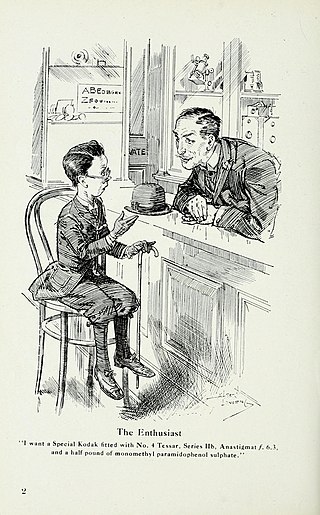
A consumer is a person or a group who intends to order, or use purchased goods, products, or services primarily for personal, social, family, household and similar needs, who is not directly related to entrepreneurial or business activities. The term most commonly refers to a person who purchases goods and services for personal use.
Egalitarianism, or equalitarianism, is a school of thought within political philosophy that builds on the concept of social equality, prioritizing it for all people. Egalitarian doctrines are generally characterized by the idea that all humans are equal in fundamental worth or moral status. As such, all citizens of a state should be accorded equal rights and treatment under the law. Egalitarian doctrines have supported many modern social movements, including the Enlightenment, feminism, civil rights, and international human rights.

Marketing is the act of satisfying and retaining customers. It is one of the primary components of business management and commerce.

Consumerism is a social and economic order in which the goals of many individuals include the acquisition of goods and services beyond those that are necessary for survival or for traditional displays of status. Consumerism has historically existed in many societies, with modern consumerism originating in Western Europe before the Industrial Revolution and becoming widespread around 1900. In 1899, a book on consumerism published by Thorstein Veblen, called The Theory of the Leisure Class, examined the widespread values and economic institutions emerging along with the widespread "leisure time" at the beginning of the 20th century. In it, Veblen "views the activities and spending habits of this leisure class in terms of conspicuous and vicarious consumption and waste. Both relate to the display of status and not to functionality or usefulness."

Karl Marx's theory of alienation describes the estrangement of people from aspects of their human nature as a consequence of the division of labor and living in a society of stratified social classes. The alienation from the self is a consequence of being a mechanistic part of a social class, the condition of which estranges a person from their humanity.

A service is an act or use for which a consumer, firm, or government is willing to pay. Examples include work done by barbers, doctors, lawyers, mechanics, banks, insurance companies, and so on. Public services are those that society as a whole pays for. Using resources, skill, ingenuity, and experience, service provider's benefit service consumers. Services may be defined as intangible acts or performances whereby the service provider provides value to the customer.

In Marxist philosophy, the term commodity fetishism describes the economic relationships of production and exchange as being social relationships that exist among things and not as relationships that exist among people. As a form of reification, commodity fetishism presents economic value as inherent to the commodities, and not as arising from the workforce, from the human relations that produced the commodity, the goods and the services.

Bottled water is drinking water packaged in plastic or glass water bottles. Bottled water may be carbonated or not. Sizes range from small single serving bottles to large carboys for water coolers.
Ethical consumerism is a type of consumer activism based on the concept of dollar voting. People practice it by buying ethically made products that support small-scale manufacturers or local artisans and protect animals and the environment, while boycotting products that exploit children as workers, are tested on animals, or damage the environment.

Economic materialism can be described as either a personal attitude that attaches importance to acquiring and consuming material goods or as a logistical analysis of how physical resources are shaped into consumable products.

Consumption is the act of using resources to satisfy current needs and wants. It is seen in contrast to investing, which is spending for acquisition of future income. Consumption is a major concept in economics and is also studied in many other social sciences.

Consumer behaviour is the study of individuals, groups, or organisations and all the activities associated with the purchase, use and disposal of goods and services. Consumer behaviour consists of how the consumer's emotions, attitudes, and preferences affect buying behaviour. Consumer behaviour emerged in the 1940–1950s as a distinct sub-discipline of marketing, but has become an interdisciplinary social science that blends elements from psychology, sociology, social anthropology, anthropology, ethnography, ethnology, marketing, and economics.
Cooperative federalism is a school of thought in the field of cooperative economics. Historically, its proponents have included J.T.W. Mitchell, Charles Gide, Paul Lambert, and Beatrice Webb.
Emotional branding is a term used within marketing communication that refers to the practice of building brands that appeal directly to a consumer's emotional state, needs and aspirations. Emotional branding is successful when it triggers an emotional response in the consumer, that is, a desire for the advertised brand that cannot fully be rationalized. Emotional brands have a significant impact when the consumer experiences a strong and lasting attachment to the brand comparable to a feeling of bonding, companionship or love. Examples of emotional branding include the nostalgic attachment to the Kodak brand of film, bonding with the Jim Beam bourbon brand, and love for the McDonald’s brand.
Collaborative consumption is the set of those resource circulation systems in which consumers both "obtain" and "provide", temporarily or permanently, valuable resources or services through direct interaction with other consumers or through a mediator. It is sometimes paired with the concept of the "sharing economy". Collaborative consumption is not new; it has always existed.

The United States is the largest consumer market for bottled water in the world, followed by Mexico, China, and Brazil.
Sustainability marketing myopia is a term used in sustainability marketing referring to a distortion stemming from the overlooking of socio-environmental attributes of a sustainable product or service at the expenses of customer benefits and values. Sustainability marketing is oriented towards the whole community, its social goals and the protection of the environment. The idea of sustainability marketing myopia is rooted into conventional marketing myopia theory, as well as green marketing myopia.
Theories of consumption have been a part of the field of sociology since its earliest days, dating back, at least implicitly, to the work of Karl Marx in the mid-to-late nineteenth century. Sociologists view consumption as central to everyday life, identity and social order. Many sociologists associate it with social class, identity, group membership, age and stratification as it plays a huge part in modernity. Thorstein Veblen's (1899) The Theory of the Leisure Class is generally seen as the first major theoretical work to take consumption as its primary focus. Despite these early roots, research on consumption began in earnest in the second half of the twentieth century in Europe, especially Great Britain. Interest in the topic among mainstream US sociologists was much slower to develop and it is still not a focal concern of many American sociologists. Efforts are currently underway to form a section in the American Sociological Association devoted to the study of consumption.
Critical consumption is the conscious choice to buy or not buy a product because of ethical and political beliefs. The critical consumer considers characteristics of the product and its realization, such as environmental sustainability and respect of workers’ rights. Critical consumers take responsibility for the environmental, social, and political effects of their choices. The critical consumer sympathizes with certain social movement goals and contributes towards them by modifying their consumption behavior.

Nostalgia consumption is a social and cultural trend that could be described as the act of consuming goods that elicit memories from the past, being associated with the feeling of nostalgia.














